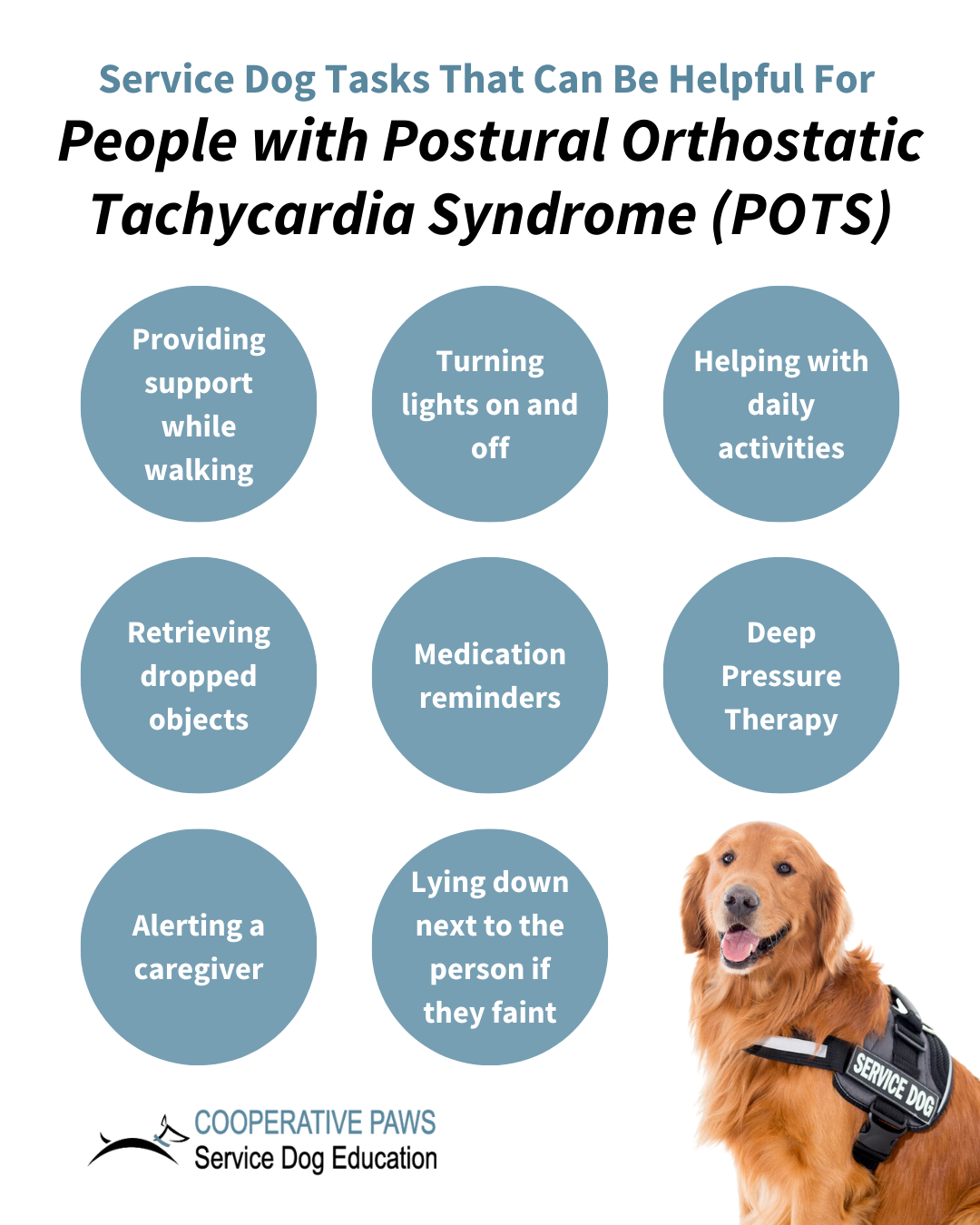How to Train a Service Dog for POTS? To train a service dog for POTS (Postural Orthostatic Tachycardia Syndrome), start with basic obedience training. Gradually introduce tasks that help manage symptoms, such as alerting and providing support.
Training a service dog for POTS can significantly improve the quality of life for those affected. POTS is a condition that impacts blood flow, causing dizziness and fatigue. Service dogs can assist by offering physical support, alerting to symptoms, and retrieving items.
A well-trained service dog can help individuals maintain independence while managing daily challenges. Training requires patience, consistency, and a clear understanding of the specific needs related to POTS. By focusing on essential tasks, both the handler and the dog can build a strong partnership that enhances daily activities and emotional well-being.

Credit: abcnews.go.com
Table of Contents
Introduction To Service Dogs For Pots
Service dogs can change lives for people with POTS. These dogs assist with daily tasks. They provide support and companionship. Many people with Postural Orthostatic Tachycardia Syndrome (POTS) benefit from their help.
The Role Of Service Dogs In Managing Pots
Service dogs play a crucial role in managing POTS symptoms. They are trained to perform specific tasks. Here are some key roles they fulfill:
- Alerting to changes in heart rate.
- Providing balance during sudden dizziness.
- Fetching medication or water.
- Guiding to a safe place when feeling faint.
These tasks help improve independence. They also boost confidence in daily activities.
Benefits Of Having A Service Dog For Pots Patients
Having a service dog offers numerous benefits. Here are some of the most significant:
| Benefit | Description |
|---|---|
| Increased Mobility | Dogs assist during episodes of weakness or fatigue. |
| Emotional Support | They provide companionship and reduce anxiety. |
| Enhanced Safety | Dogs can alert others during medical emergencies. |
| Social Interaction | Service dogs encourage conversations and friendships. |
These benefits contribute to a better quality of life. Patients feel more secure and less isolated.

Credit: www.instagram.com
Qualities Of A Potential Service Dog
Choosing the right service dog for POTS (Postural Orthostatic Tachycardia Syndrome) is essential. A service dog must possess specific qualities. These qualities ensure they can assist effectively. Understanding these traits helps in selecting the perfect companion.
Breed Considerations
Not all dog breeds make suitable service dogs. Some breeds have natural abilities that fit this role well.
| Breed | Traits |
|---|---|
| Golden Retriever | Friendly, intelligent, and eager to please. |
| Labador Retriever | Loyal, gentle, and strong. |
| Standard Poodle | Smart, hypoallergenic, and energetic. |
| German Shepherd | Protective, trainable, and versatile. |
Choose a breed that suits your lifestyle. Consider size, energy levels, and grooming needs.
Temperament And Behavior Traits
A service dog must have a calm and steady temperament. Look for the following traits:
- Calmness: Must remain calm in various situations.
- Confidence: Should not be easily frightened.
- Trainability: Must learn commands quickly.
- Socialization: Should be friendly with people and other animals.
- Focus: Needs to stay attentive to tasks.
These traits help the dog perform its duties well. A good service dog remains focused on its handler’s needs.
Legal Requirements And Certifications
Understanding the legal requirements for training a service dog is crucial. These laws ensure proper access and support for individuals with disabilities. Knowing the rules helps you navigate the process smoothly.
Understanding Ada Guidelines
The Americans with Disabilities Act (ADA) provides essential guidelines for service dogs. Here are some key points:
- Definition: A service dog is trained to assist a person with a disability.
- Public Access: Service dogs can enter all public spaces.
- Types of Disabilities: The ADA recognizes physical and mental disabilities.
- Emotional Support Animals: These are not considered service dogs.
Under ADA, businesses cannot ask for proof of certification. They can only ask if the dog is a service animal and what tasks it performs.
Service Dog Certification Process
While the ADA does not require certification, training is essential. Here’s how to ensure your dog meets the standards:
- Assess Needs: Identify specific tasks your dog will perform.
- Choose Training Program: Select a reputable program or trainer.
- Train Your Dog: Focus on basic obedience and task training.
- Public Access Test: Ensure your dog behaves in public spaces.
- Obtain Certification: Some organizations offer certificates upon completion.
Consider the following table for service dog organizations:
| Organization | Certification Offered | Website |
|---|---|---|
| International Association of Assistance Dog Partners | Advocacy & Resources | iaadp.org |
| Service Dogs International | Certification & Training | servicedogs.org |
| Assistance Dogs International | Standards & Certification | assistancedogsinternational.org |
Follow these steps to ensure your service dog is trained and recognized. This knowledge empowers you and helps you advocate for your rights.
Basic Training Fundamentals
Training a service dog for POTS (Postural Orthostatic Tachycardia Syndrome) starts with solid fundamentals. These basics ensure your dog becomes a reliable support. Focus on two main areas: socialization and obedience. Both are crucial for a successful partnership.
Socialization And Exposure
Socialization helps your dog become comfortable in different environments. It builds confidence and reduces anxiety. Here are some key points for effective socialization:
- Introduce your dog to various people.
- Expose your dog to different sounds and sights.
- Visit busy places like parks or markets.
- Encourage interaction with other dogs.
Start socialization early. Puppies are more adaptable. Use treats to reward positive behavior.
Obedience Training Essentials
Obedience training is vital for safety and control. Teach your dog basic commands. These commands include:
- Sit
- Stay
- Come
- Down
- Heel
Practice commands in various environments. This helps reinforce learning. Use positive reinforcement techniques. Treats, praise, and playtime work well.
A consistent training schedule is essential. Regular practice helps your dog remember commands. Keep training sessions short, about 5-10 minutes each.
Specialized Task Training For Pots
Training a service dog for POTS involves specialized tasks. These tasks help manage symptoms and improve daily life. A well-trained service dog can provide significant support.
Tasks To Mitigate Pots Symptoms
Service dogs can perform several tasks for those with POTS. Here are some key tasks:
- Fetching items: Dogs can bring medication or water.
- Deep pressure therapy: They can apply pressure during dizziness.
- Brace for support: Dogs can help with balance.
- Alerting: They can signal when symptoms worsen.
- Guiding: Dogs can lead to a safe space.
Training Methods For Specific Tasks
Use clear methods for training service dogs. Here are some effective approaches:
- Positive reinforcement: Reward good behavior with treats.
- Clicker training: Use a clicker to mark desired actions.
- Task repetition: Practice tasks until they are mastered.
- Desensitization: Expose dogs to various situations gradually.
Consistency is vital during training. Use short sessions to keep the dog engaged. Monitor progress and adjust methods as needed.
| Task | Training Method |
|---|---|
| Fetching Items | Positive reinforcement with treats |
| Deep Pressure Therapy | Clicker training for specific actions |
| Brace for Support | Task repetition for reliability |
| Alerting | Desensitization to triggers |
| Guiding | Positive reinforcement for guidance |
Public Access Training
Public access training is crucial for service dogs. It prepares them to behave well in various environments. This training ensures they support their handlers effectively.
Navigating Public Spaces
Service dogs must learn to navigate public spaces confidently. This includes busy streets, stores, and restaurants. Here are key points to consider:
- Start in quiet areas: Begin training in low-traffic locations.
- Gradually increase difficulty: Move to busier places as skills improve.
- Use a leash: Keep the dog close to maintain control.
- Practice commands: Reinforce basic commands like sit, stay, and heel.
Consistency in training helps the dog adjust to different environments. Frequent practice builds confidence for both the dog and handler.
Handling Distractions And Interactions
Distractions can occur in public spaces. Training your service dog to ignore distractions is essential. Here are effective strategies:
- Introduce distractions slowly: Start with minimal distractions.
- Reward calm behavior: Use treats and praise for good behavior.
- Practice with people: Teach the dog to greet calmly.
- Use “leave it” command: Train the dog to ignore specific distractions.
Regular practice helps your dog stay focused. This is important for their role as a service dog.
Health And Wellness Management
Training a service dog for POTS involves more than commands. Health and wellness management are crucial. A healthy dog provides better support. Regular care ensures your dog stays in top shape.
Regular Veterinary Care
Regular veterinary visits keep your service dog healthy. Schedule check-ups at least once a year. Vaccinations and health screenings are essential. Here are key points to consider:
- Annual vaccinations
- Routine dental check-ups
- Parasite prevention
- Weight management
Keep track of your dog’s health records. Use a chart to monitor vaccinations and treatments:
| Vaccination | Date Administered | Next Due |
|---|---|---|
| Rabies | 01/15/2023 | 01/15/2024 |
| Distemper | 01/15/2023 | 01/15/2024 |
Emotional And Physical Well-being
Your service dog’s emotional health matters. Happy dogs are better helpers. Provide regular exercise and socialization. Here are ways to promote well-being:
- Daily walks or runs
- Playtime with other dogs
- Positive reinforcement training
- Safe spaces for relaxation
Monitor signs of stress or anxiety. Look for changes in behavior. A happy dog leads to a better support experience. Always prioritize their mental health.
Credit: www.tiktok.com
Building A Bond With Your Service Dog
Creating a strong bond with your service dog is essential. A solid relationship improves training and enhances teamwork. Trust and communication between you and your dog are vital.
The Importance Of A Strong Handler-dog Relationship
A strong handler-dog relationship leads to success. Here are some reasons why it matters:
- Trust: Your dog needs to trust you completely.
- Responsiveness: A well-bonded dog listens better.
- Confidence: Your dog will feel safe with you.
- Teamwork: Good communication fosters teamwork.
Bonding helps your dog understand commands. It also makes training enjoyable for both of you.
Activities To Strengthen Your Bond
Engaging in fun activities strengthens your bond. Here are some effective ideas:
- Daily walks: Explore new paths together.
- Playtime: Use toys your dog loves.
- Training sessions: Keep them short and fun.
- Relaxation time: Cuddle or sit quietly together.
Consider these activities:
| Activity | Benefits |
|---|---|
| Fetch | Encourages play and exercise. |
| Obstacle courses | Builds confidence and skills. |
| Agility training | Strengthens focus and teamwork. |
Regular activities enhance your relationship. A strong bond makes your service dog more effective.
Troubleshooting Common Training Challenges
Training a service dog for POTS can be rewarding but challenging. Setbacks often occur during the process. Understanding how to manage these challenges is key. This section will help you navigate common issues.
Dealing With Setbacks
Setbacks can happen for various reasons. Here are some common causes:
- Lack of consistency in training.
- Environmental distractions.
- Health issues affecting the dog or handler.
Follow these steps to overcome setbacks:
- Reassess your training plan. Adjust your goals if needed.
- Increase training frequency. Short, frequent sessions work best.
- Limit distractions. Train in a quiet space.
- Be patient. Progress takes time.
Keep a training journal. Document successes and areas for improvement. This will help you stay motivated.
When To Seek Professional Help
Sometimes, professional guidance is necessary. Consider seeking help in these situations:
- Persistent behavioral issues.
- Inconsistent training results.
- Health concerns affecting your dog.
Finding the right trainer is crucial. Look for:
| Criteria | Description |
|---|---|
| Experience | Look for trainers with a background in service dog training. |
| Approach | Choose positive reinforcement methods. |
| Reviews | Check client testimonials for effectiveness. |
Professional help can accelerate training. It ensures your dog is well-prepared for service tasks.
Continued Education And Training
Training a service dog for POTS requires ongoing education. Skills need to be maintained and advanced over time. This ensures the dog remains effective and responsive. Consistent training builds a strong bond between the handler and the dog.
Maintaining Skills Over Time
Regular practice helps reinforce learned behaviors. Here are some tips:
- Schedule weekly training sessions.
- Use positive reinforcement techniques.
- Incorporate real-life scenarios.
- Monitor your dog’s performance.
Keep training sessions short and engaging. Dogs learn best in a fun environment. Consistency is key. Use rewards to motivate your dog.
Advanced Training Opportunities
Consider enrolling in advanced training classes. These classes can enhance your dog’s skills. Look for programs focused on:
| Training Focus | Description |
|---|---|
| Task Specific Training | Teach your dog specific tasks for POTS. |
| Socialization | Expose your dog to different environments. |
| Public Access Training | Prepare your dog for public situations. |
Join local training groups. Networking with other handlers is valuable. Share experiences and tips. This fosters a supportive community.
Frequently Asked Questions
How Do I Start Training A Service Dog For Pots?
Begin by establishing a strong bond with your dog. Use positive reinforcement techniques, such as treats and praise. Focus on basic commands like sit and stay before moving on to specific tasks. Consistency is key, so practice regularly in different environments to build confidence and skills.
What Tasks Can A Service Dog Perform For Pots?
Service dogs for POTS can perform various tasks. They can alert you to changes in your condition, retrieve items, or provide physical support when standing. Additionally, they can help with mobility by guiding you to a safe place. Each task should be tailored to your specific needs.
How Long Does It Take To Train A Service Dog?
Training a service dog typically takes six months to two years. The duration depends on the dog’s age, temperament, and the complexity of tasks. Consistent training sessions and practice are essential for success. Always remember to be patient and celebrate small achievements along the way.
Can Any Dog Become A Service Dog For Pots?
Not every dog is suitable for service work. Ideal candidates are calm, intelligent, and eager to please. Breeds like Labrador Retrievers and Golden Retrievers often excel in this role. Assess your dog’s temperament and abilities to determine if they can be trained effectively for your needs.
Conclusion
Training a service dog for POTS can greatly enhance your quality of life. Consistency and patience are key throughout the training process. Remember to celebrate small victories along the way. With dedication, you can create a strong bond with your service dog, ensuring they become a reliable companion in managing your condition.



